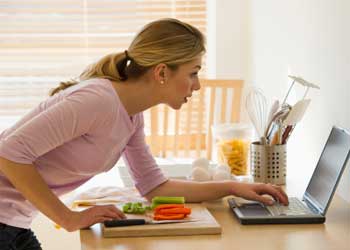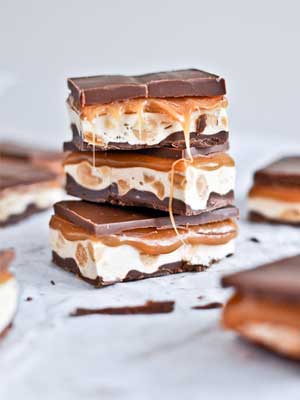We’ve all been there: It’s late, you’re scrolling through Pinterest and you see a sexy photo of an ice cream-topped brownie with a thick drizzle of fudge running down the side. On top? A hefty mound of fresh whipped cream and plenty of strawberries. Immediately, you’re sucked in: You need that brownie.
Whether this has happened to you or not, you’ve likely heard of the phenomenon that’s now commonly known as “food porn.”
As a food blogger and food gawker myself, food porn has affected me over and over again. Just this summer while visiting friends in Portland, I stumbled across a photo on Pinterest of a chocolate chip skillet cookie. In that moment, I decided I absolutely had to have some for myself. Hours later I was happy as a pig, mindlessly eating my own thick slice of ice cream-topped cookie pie.
Pinterest isn’t the only website pimping out its tantilizing food photos. In fact, it’s just the beginning. Dozens of other food sites like Foodgawker, Tastespotting and Dessert Stalking host a wide array of tempting food photos, with the cheesiest, gooey-est and most comforting shots often gaining the most attention.
One site forgoes beating around the bush at all with its bold name, Food Porn Daily. The site features a new drool-worthy photo every few days with its standard being only the most jaw-dropping, sexy food images on the web. One stop there will have you convinced you need a slice of apple pie on your plate within seconds.
The term “food porn” is now practically a household name, highlighting our culture’s full-on obsession with all-things food – the sexier the better. One search on Twitter with the hashtag “#foodporn” will yield an endless stream of up close and personal food photos for your gawking delight.
 Urban Dictionary defines food porn as “taking mouthwatering pictures of delicious foods and proliferating them throughout various social media websites as status updates, thus tempting all those not even currently hungry into…getting food-horny and blowing all of their heroic dieting efforts to hell.”
Urban Dictionary defines food porn as “taking mouthwatering pictures of delicious foods and proliferating them throughout various social media websites as status updates, thus tempting all those not even currently hungry into…getting food-horny and blowing all of their heroic dieting efforts to hell.”
Joking aside, ever since the food porn phenomenon surfaced some have naturally started to wonder what kind of effect it’s having on our psyches and our waistlines. After all, is all that hot and heavy food stalking healthy, or is it actually posing a dangerous threat to our health?
Numerous studies on the topic have tried to answer that very question, including one published in The Journal of Neuroscience that found viewing over-the-top images of delicious food activated the brain’s reward center and caused participants with a high active mental response to overeat.
As reported by Women’s Health, a similar study in the journal Obesity found that the very act of looking at food increases levels of the hunger hormone gherkin, whether we’re actually hungry or not. Furthermore, the part of our brain that enables us to practice self-control actually fails to kick in with food porn the way it does with actual food.
“Like the sexual kind, food porn allows us to lust after taboo things,” said Susan Albers, Psy.D., author of Eating Mindfully. Harvard evolutionary psychologist Deirdre Barrett, Ph.D. agrees, saying, “Food porn relies on a phenomenon called supernormal stimuli, which exaggerates qualities we’re already hardwired to love.”
One blogger who may just be the queen of over-the-top decadent food photos is Jessica Merchant of How Sweet It Is. A recipe she posted earlier this year for “Homemade Snickers Bars” had people practically sweeping up their jaws from their keyboards and wiping away drool.
In addition to racking up nearly 25,000 views on Foodgawker, the post earned 8,000 Facebook “likes,” 330 shares on Twitter and nearly 600 comments on her blog. Needless to say, Merchant knows a thing or two about what makes a food image compelling.
“I’m not exactly sure why this happens but I think seeing a gooey brownie or a big slice of cake just gets others really excited, because it’s not something you get to eat everyday,” she said. “It sort of blows my mind, but I think in general the crazier the food photo, the more people that go nuts over it.”
When it comes to the term food porn, Merchant tends to stay away from it, finding it generally distasteful. “Personally I really dislike the term ‘food porn,’ maybe because of the word porn in general. But the whole thing just rubs me the wrong way. I never use the term and pretty much stay away from projects or places that do use the term.”
As for whether or not she feels personally affected by food porn, Merchant says she doesn’t, but that may be because it’s her full-time job. “I’ve also always had a really healthy relationship with food (I’ve been really lucky) and seeing pictures doesn’t necessarily make me eat junk food,” she said. “I can decipher between a photo looking incredible and the food that I need to give my body.”
DietsInReview.com’s resident dietitian, Mary Hartley, RD tries to stay away from food porn as well, finding both the term and the concept unappetizing. However, she’s not opposed to the actual act of photographing food as she believes it can have some tangible health benefits.
From a dietitian’s perspective, Mary believes taking and sharing pictures of our food can be a positive trend just as much as a negative one. “Fans tell me that taking pictures for weight loss helps to create mindfulness, accountability, and inspiration. Taking food pictures unrelated to weight loss is a source of pride, connection and entertainment.” On the other hand, she believes it can be harmful as well. “I can see where food photos might take the place of eating for anorexics. It might also be annoying to dining companions – but that’s not harmful.”
Mary explained that food porn is such a generational thing that only affects people who’ve grown up in the digital age and since the start of the Food Network in 1993. “There’s a part of it that seems juvenile (“Look at me!”) and then there’s the bazillion housewives who cooked at least 15,000 suppers apiece that no one recorded. Somehow, it doesn’t seem fair,” she said.
Though Mary often dines with her daughter and friends who take food photos on occasion, she admits it’s not for her. However, she is interested in the concept from a nutrition/public health intervention perspective. “Since it’s useful and free and people enjoy it, let’s encourage it and do some research.”
Whether or not food porn really does affect the way we view food and master our appetites, one thing we know for sure is that it’s not going anywhere soon. Food search engines are popping up left and right, Google is starting to cater to recipe searches more and more, and new food picture sites are surfacing on what seems a weekly basis.
Our best piece of advice to avoid getting consumed in the trend? Gawk, share and drool all you want, but be sure to re-examine your habits if it starts to negatively affect your diet. Otherwise, it may end up sabotaging not only your eating habits, but also your relationship with food.
Also Read:
Joy the Baker’s “Friend Diet” is like Calorie Counting Without Calories or Counting
10 Ways Pinterest Supports Weight Loss
Romney vs. Obama Recipe Cook-Off: Romney’s Meatloaf Against Obama’s Chili
Snickers image via How Sweet It Is
